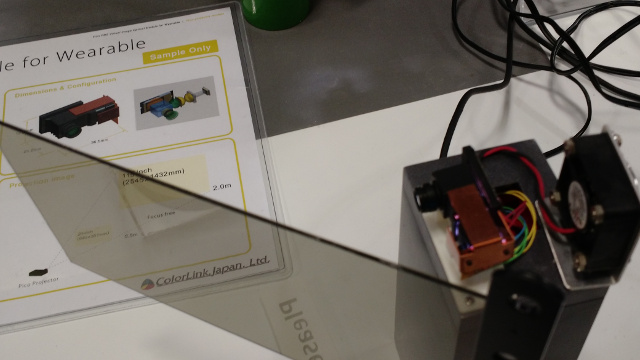Below is a summary of some of the projection-related news we saw on the exhibit floor at SID.
Moxtek has supplied their Wire Grid Polarizer (WGP) for projection applications for a long time. This is a high quality polarizer fabricated with fine metal lines on a glass substrate. It is used where optical flux densities are high and where high extinction ratios are needed – mainly at the heart of a 3LCD or LCOS engine.
At SID, the company was showing off their new ICE Cube polarizing beamsplitter design. This is an embedded WGP placed at a 45-degree angle and sandwiched between two pieces of high quality BK7 glass to form a cube with dimensions of 25.4mm on a side. It accepts unpolarized light and separates it into two polarized components (p-polarized with is transmitted thru the WGP and s-type polarization which is reflected by the WGP). They see this as a nice component for A/R headsets, projection applications or HUDs.
The design was compared to a MacNeille type prism polarizer. This type of polarizer consists of a pair of right angle prisms with a multilayer coating at the cemented interface and antireflection coatings on the legs to increase overall transmission.
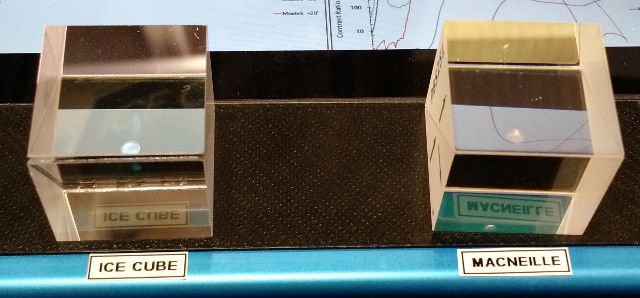
The chart below shows the performance comparison. The big advantage of the ICE Cube design is the maintenance of the high p-polarization transmittance over a wide angle (+/- 20 degrees) and high contrast over this same angular range. The MacNeille prism struggles to maintain performance over such a wide acceptance angle. This is important for uniformity when you have optical solutions with a low f-number, like LCOS.
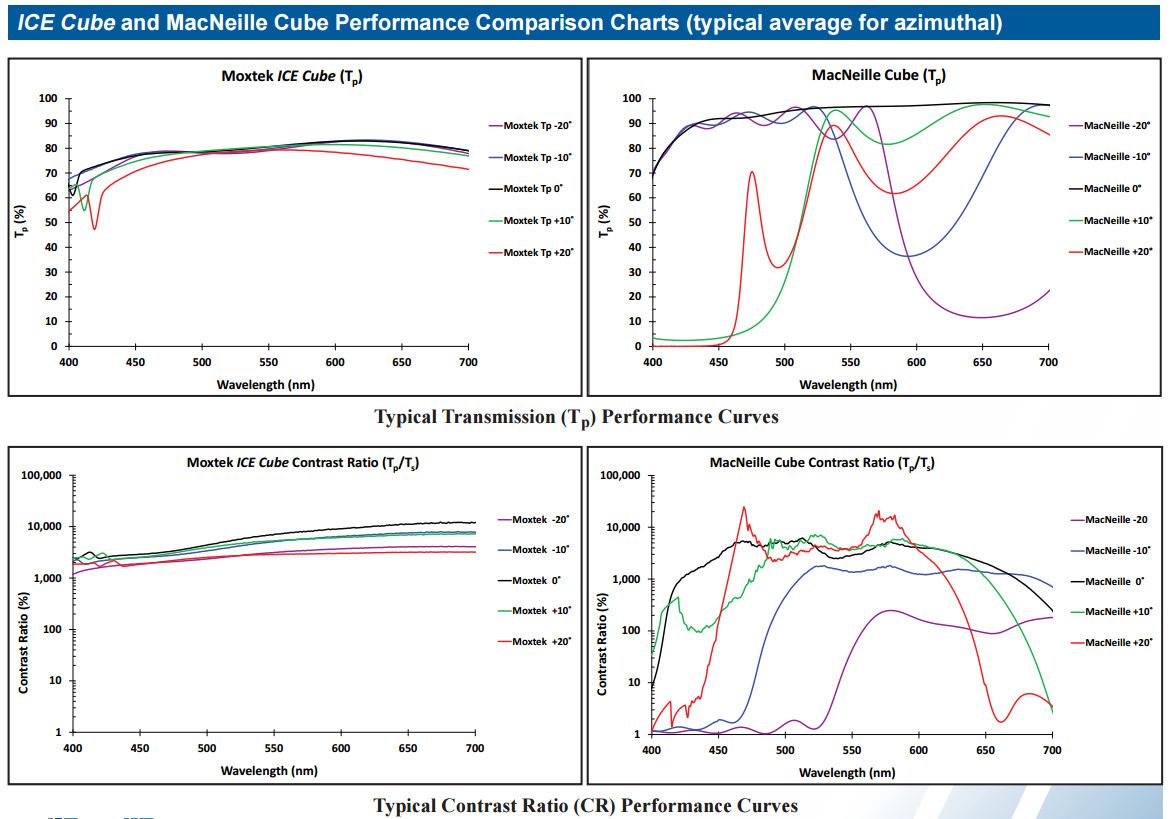
DNP and The Kroger Co. teamed up to create a novel and effective store shelf labeling solution – based on projection! The unit is thin – 2” or 4” tall and wide at 48″. It is a rear projection solution that is 20” deep, but can fit on shelves that are 20″ to 36″ deep. It creates a nice bright, colorful image just below the shelf in the supermarket.
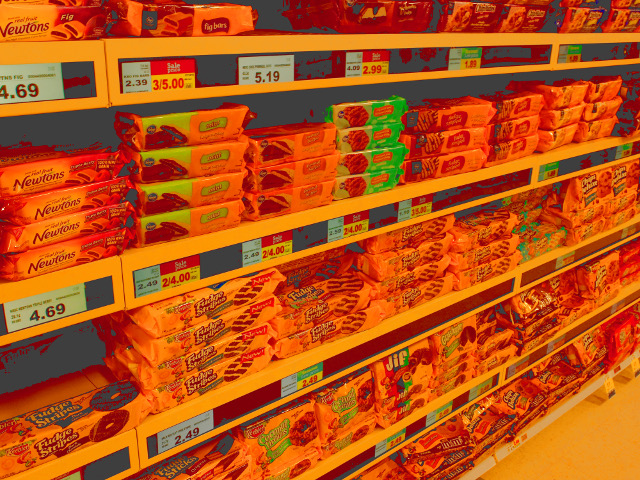
Kroger says they have installed about 2000 units in their test store in Cincinnati and have been gathering customer feedback. The larger font size and easy readability is one of the key value propositions, said Kroger R&D Manager, Titus Jones. These customer evaluations are carried out by their advertising department with this new solution being one of many new ideas they test and evaluate. The unit is tied to their point of sale system so always has up to date information and can be used to promote specials on any time scale. Jones says they will soon have a management review and he is optimistic they will roll the system out to other stores as well.
The system was designed in house by Kroger and is essentially a narrow slice out of a larger projection solution. The projector is LCOS based and uses a 4K-UHD resolution imager, so only a very narrow window of this image is actually projected (3840×160 for the 2″ model). Clearly, there is room for a more custom solution in the engine. The screen comes from DNP and is a Fresnel design that again, has been cut to this severe aspect ratio.
The unit includes a full Android system and can support a range of sensors (such as some that can detect how much is inventory has been taken from the shelf) as well as integrating back into the retailers’ systems. We heard that the use of a continuous image over the width of the shelf (unlike individual ESLs) can be used to indicate, for example, how much of the shelf should be used for stocking a particular product. The system also has a ‘staff’ mode that can be used to allow staff to get a different display from that seen by consumers.
Kroger is a major grocery market chain and is the third largest grocery retailer in the world. They have 37 manufacturing plants, I was told, so this could be a sizable opportunity.
SK Telecom was showing off their new cube-shaped pico projector called the Smart Beam Laser (which we have been reporting on since MWC in 2015). It measures 55mm on a side, offers HD resolution and has 100 lumens of light output today, going to 200 lumens soon. It is powered by an LCOS engine with RGB laser diodes as the light source. The red laser (640 nm) comes from Mitsubishi, while the green (520nm) and blue (445nm) lasers are sources from Nichia.
The projection distance is 0.5 to 3 meters, but there is no projection lens needed – it is focus free! A 1W stereo speaker is included. Connectivity is via HDMI, Miracast or DLNA.
The product has been selling in Korea, but is now available on Amazon for $360 for the 100 lumen version.
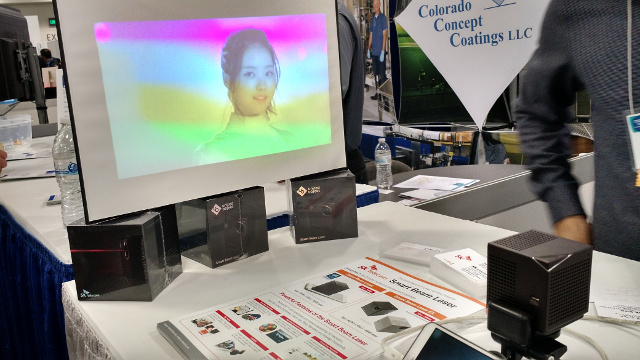
ColorLink Japan was showing a number of items including the E5-DiLL, an embedded digital illumination module. This uses a 0.26” LCOS panel with 1280×720 resolution and RGB LEDs to offer about 16 lumens of light – not very much to be very interesting, one would think. But it is tiny.
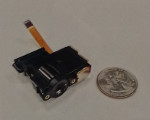
The company was also showing a beamsplitter prototype demo for AR use. It was being illuminated with a Sony 0.7” OLED panel with FHD resolution. The field of view was an incredible 70 degrees! ColorLink Japan says they are working with Sony on this solution.
The third demo featured a small, body-worn projector in combination with a special screen, which is necessary to see the image. The company thinks a user can lay out this screen, put on their headset with the projector and have nice private big screen. This use case seems dubious to me – do you really want to drag a screen and head set around to get a hands-free image that may not be very bright nor high resolution?
That’s it for our summary of projection technology on the show floor at SID DisplayWeek 2016 – CC
